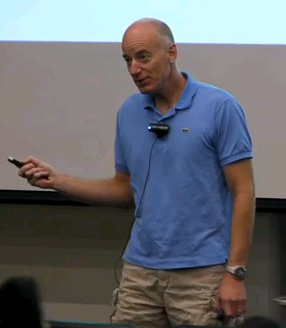UCI Chem 131C Thermodynamics and Chemical Dynamics (Spring 2012)
Lec 18. Thermodynamics and Chemical Dynamics -- Equilibrium In Action --
View the complete course: ../courses/chem_131c_thermodynamics_and_chemical_dynamics.html
Instructor: Reginald Penner, Ph.D.
License: Creative Commons BY-NC-SA
Terms of Use: ../info.
More courses at http://ocw.uci.edu
Description: In Chemistry 131C, students will study how to calculate macroscopic chemical properties of systems. This course will build on the microscopic understanding (Chemical Physics) to reinforce and expand your understanding of the basic thermo-chemistry concepts from General Chemistry (Physical Chemistry.) We then go on to study how chemical reaction rates are measured and calculated from molecular properties. Topics covered include: Energy, entropy, and the thermodynamic potentials; Chemical equilibrium; and Chemical kinetics. This video is part of a 27-lecture undergraduate-level course titled "Thermodynamics and Chemical Dynamics" taught at UC Irvine by Professor Reginald M. Penner.
Thermodynamics and Chemical Dynamics (Chem 131C) is part of OpenChem: ../openchem/
Recorded on May 14, 2012.
Index of Topics:
00:06 - Introduction - Equilibrium in Action
00:21 - Good job on Quiz 5
01:19 - Today
01:45 - the chemical potential of species...
02:34 - ...think about this way "...Gibbs energy"
03:33 - about μ, you should know...
04:44 - now, before we go further, let's clear up a mystery...
05:31 - Diagram
06:36 - Diagram: This is the positive entropy of mixing - the reason equilibrium exists.
07:39 - Consider this generic reaction ("extent of reaction...)
08:07 - For example, if ΔΕ...
08:30 - now, our plot of G versus reaction coordinate can be recast...
08:48 - we define the slope of this plot at any value of E...
09:47 - so under conditions of const. P and...
10:54: so as a function of E...
11:35 - ok, but we still have not learned any more about WHERE equilibrium is located...
12:43 - we define a standard molar Gibbs free energy...
13:41 - ok, now for every value...
15:10 - In other words...
15:45 - what does this mean?
16:17 - ok, make sense. What about...
17;36 - ...refresher on...("from Chem 1...")
18:54 - returning to our plot, we can say...
20:01 - example: A mixture of CO(g)...
21:41 - Diagram: our reaction looks like this...
24:10 - answer: 2) write an expression for...
24:39 - answer: 3) Calculate K:
25:29 - we know Q and K - what happens?
25:47 - Calculate
26:35 - ...means reaction, at this temperature and with this mix...
27:28 - example: What if, instead of...
28:26 - "we will make a little more methanol...by adding more..."
29:26 - example: Consider the following reaction...
36:48 - answer
39:58 - Henry Louis Le Chatelier (1850 - 1936)
40:19 - (cont) "I let the discovery of the ammonia synthesis slip through my hands..."
42:35 - the most influential persons of the 20th century?
44:17 - where did fixed nitrogen come from before 1920?
45:48 - Le Chatelier's Principle says, for example...that with an increase...
47:22 - Example: Can we determine the relationship between...
47:44 - answer: " we have to calculate the mole fraction of each of these two components..."
Required attribution: Penner, Reginald Thermodynamics and Chemical Dynamics 131C (UCI OpenCourseWare: University of California, Irvine), ../courses/chem_131c_thermodynamics_and_chemical_dynamics.html. [Access date]. License: Creative Commons Attribution-ShareAlike 3.0 United States License.


